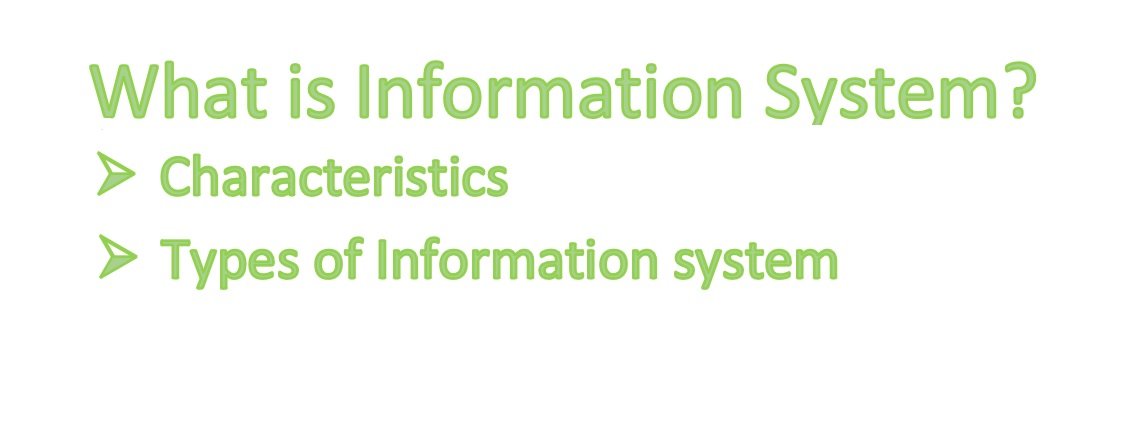What is Information System? Definition, Characteristics and Types of information System.
What is Information System?
An information System can be seen as the organized combination of people, hardware, Software, communication, networks, data resources, policies and procedures, that stores, retrieves, transforms and disseminates, information in an organization. Various types of physical devices (hardware), information processing instructions in the form of flow charts and structed languages (software), communication channel (Networks) and stored data or information are used by people or machines to communication and gather information knowledge and wisdom in this digital age.

Definition :
“Information systems are combinations of hardware, software, and telecommunications networks that people build and use to collect, create, and distribute useful data, typically in organizational settings.”
OR
”An information system is a set of interrelated components that works together to collect, process, store and breakdown the information to support decision making. ”
Characteristics of Information system :
- Availability/accessibility :
Information should be easy to obtain or access. Information kept in a book of some kind is only available and easy to access if you have the book to hand. A good example of availability is a telephone directory, as every home has one for its local area. It is probably the first place you look for a local number. But nobody keeps the whole country’s telephone books so for numbers further afield you probably phone a directory enquiry number. For business premises, say for a hotel in London, you would probably use the Internet.
- Accuracy :
Information needs to be accurate enough for the use to which it is going to be put. To obtain information that is 100% accurate is usually unrealistic as it is likely to be too expensive to produce on time. The degree of accuracy depends upon the circumstances.
At operational levels information may need to be accurate to the nearest penny – on a supermarket till receipt. Accuracy is important. As an example, if government statistics based on the last census wrongly show an increase in births within an area, plans may be made to build schools and construction companies may invest in new housing developments. In these cases any investment may not be recouped.
- Reliability or objectivity :
Reliability deals with the truth of information or the objectivity with which it is presented. You can only really use information confidently if you are sure of its reliability and objectivity.
When researching for an essay in any subject, we might make straight for the library to find a suitable book.
We are reasonably confident that the information found in a book, especially one that the library has purchased, is reliable and (in the case of factual information) objective. The book has been written and the author’s name is usually printed for all to see. The publisher should have employed an editor and an expert in the field to edit the book and question any factual doubts they may have. In short, much time and energy goes into publishing a book and for that reason we can be reasonably confident that the information is reliable and objective.
- Relevance/appropriateness :
Information should be relevant to the purpose for which it is required. It must be suitable. What is relevant for one manager may not be relevant for another. The user will become frustrated if information contains data irrelevant to the task in hand.
For example, a market research company may give information on users’ perceptions of the quality of a product. This is not relevant for the manager who wants to know opinions on relative prices of the product and its rivals. The information gained would not be relevant to the purpose.
- Completeness :
- Level of detail/conciseness :
Information should be in a form that is short enough to allow for its examination and use. There should be no extraneous information. For example, it is very common practice to summarise financial data and present this information, both in the form of figures and by using a chart or graph. We would say that the graph is more concise than the tables of figures as there is little or no extraneous information in the graph or chart. Clearly there is a trade-off between level of detail and conciseness.
- Presentation :
The presentation of information is important to the user. Information can be more easily understand if it is aesthetically pleasing. For example, a marketing report that includes graphs of statistics will be more concise as well as more aesthetically pleasing to the users within the organisation. Many organisations use presentation software and show summary information via a data projector. These presentations have usually been well thought out to be visually attractive and to convey the correct amount of detail.
- Timing :
Information must be on time for the purpose for which it is required. Information received too late will be irrelevant. For example, if you receive a brochure from a theatre and notice there was a concert by your favourite band yesterday, then the information is too late to be of use.
- Value of information :
The relative importance of information for decision-making can increase or decrease its value to an organisation. For example, an organisation requires information on a competitor’s performance that is critical to their own decision on whether to invest in new machinery for their factory. The value of this information would be high. Always keep in mind that information should be available on time, within cost constraints and be legally obtained.
- Cost of information :
Information should be available within set cost levels that may vary dependent on situation. If costs are too high to obtain information an organisation may decide to seek slightly less comprehensive information elsewhere. For example, an organisation wants to commission a market survey on a new product. The survey could cost more than the forecast initial profit from the product. In that situation, the organisation would probably decide that a less costly source of information should be used, even if it may give inferior information.
Types Of Information System :
- Transaction Processing System (TPS):
- Transaction Processing System are information system that processes data resulting from the occurrences of business transactions
- Their objectives are to provide transaction in order to update records and generate reports i.e to perform store keeping function
- The transaction is performed in two ways: Batching processing and Online transaction processing.
- Example: Bill system, payroll system, Stock control system.
2. Management Information System (MIS):
- Management Information System is designed to take relatively raw data available through a Transaction Processing System and convert them into a summarized and aggregated form for the manager, usually in a report format. It reports tending to be used by middle management and operational supervisors.
- Many different types of report are produced in MIS. Some of the reports are a summary report, on-demand report, ad-hoc reports and an exception report.
- Example: Sales management systems, Human resource management system.
3. Decision Support System (DSS):
- Decision Support System is an interactive information system that provides information, models and data manipulation tools to help in making the decision in a semi-structured and unstructured situation.
- Decision Support System comprises tools and techniques to help in gathering relevant information and analyze the options and alternatives, the end user is more involved in creating DSS than an MIS.
- Example: Financial planning systems, Bank loan management systems.
4. Experts System:
- Experts systems include expertise in order to aid managers in diagnosing problems or in problem-solving. These systems are based on the principles of artificial intelligence research.
- Experts Systems is a knowledge-based information system. It uses its knowledge about a specify are to act as an expert consultant to users.
- Knowledgebase and software modules are the components of an expert system. These modules perform inference on the knowledge and offer answers to a user’s question.
More Post:

